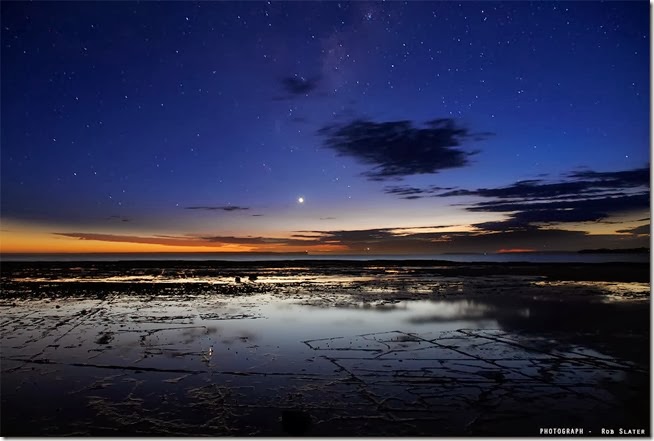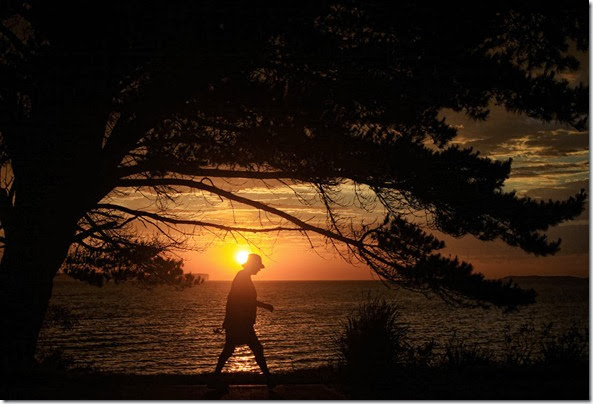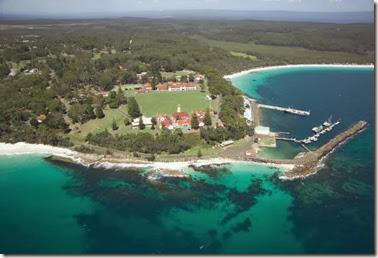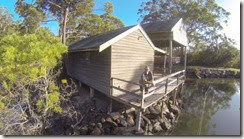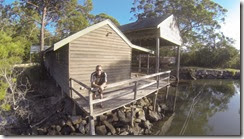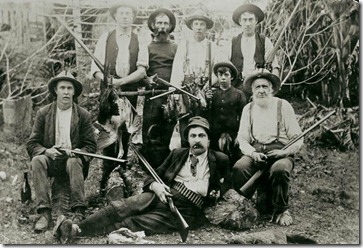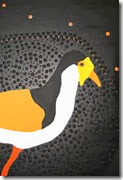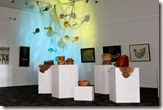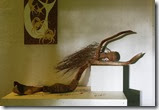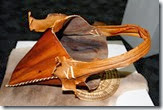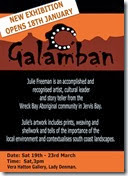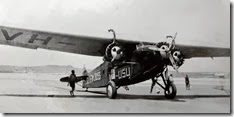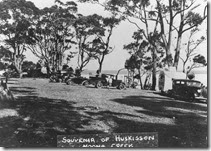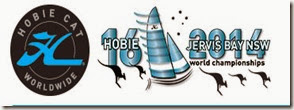 Well it’s all happening, Another piece of the Jervis Bay maritime history will be written tomorrow when the World Championships start in earnest and Husky is buzzing with activity in preparation for the event.
Well it’s all happening, Another piece of the Jervis Bay maritime history will be written tomorrow when the World Championships start in earnest and Husky is buzzing with activity in preparation for the event.
Tomorrow I will be on a boat shooting some pics of the action,
I hope they have a great championship and Jervis Bay turns on some great sailing weather.
Hobie World Championship we site.
Schedule of events.
31 January 2014
Hobie World Championships
The s.s.Dove – the last voyage
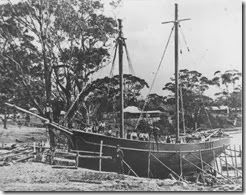
Many fine ships were built by the Dent and Setree families in Huskisson, and all of those ships have a story to tell.
Here is the story of the demise of the s.s. Dove.
Navigating the Australian Coastline was fraught with hazards.
Many ships were lost at sea and many of the ships built at Huskisson by the Dent and Setree families met their end during wild coastal storms or by running aground on uncharted reefs.
The Dove similar to this ship "Reliance" built by the Dent Family in Huskisson in 1883 came to grief during a voyage from Cairns on the 30th June, 1897, with three tons of general cargo, and three passengers, bound for Bloomfield River in northern Queensland. Passing Cape Tribulation at 4 a.m. on the 1st July in a strong SE wind and heavy sea the Captain could not correctly ascertain his position, the land being obscured, he waited until daylight to enter the river.
5.15am the Dove took to a coral reef not shown on the charts and after attempts to haul her off, her rudder and stern post were carried away making the vessel unmanageable.
The captain took the best means of saving the ship and cargo, by running her into shoal water, further inshore, where the bottom was sand.
The enquiry concluded.
We consider that owing to the thick weather the master miscalculated his distance from Cape Tribulation, therefore, was drifted closer to the shore than was advisable; at the same time if the chart had been correct, the vessel would not have been lost.
We consider that under the circumstances no blame is attributable to the master for the loss of his ship.
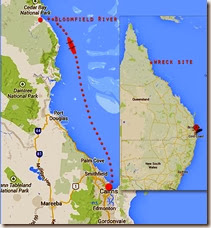
the last voyage and wreck site.
Do you have any old pictures of ships built in Jervis Bay?? If you do the Museum would be vey interested in seeing them contact me here….. yourcontributions@gmail.com
Jervis Bay
Another beautiful start to the day. Jan 31st 2014.
the Hobie Cat World Championships start today at Huskisson and don’t forget the exhibition of old surf craft at the Museum. details below.
30 January 2014
Jervis Bay looking amazing in the morning light.
Get up out of bed early and hit the many walking tracks that skirt the edge of the bay, and be rewarded with one of the most beautiful scenes in the world.
Hobie World Championships
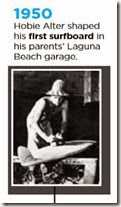 Starting Friday the 31st Feb the bay will be a hive of activity.
Starting Friday the 31st Feb the bay will be a hive of activity.
The World Hobie sailing championships will kick off with the masters event.
Over the course of two weeks we will see grand masters, masters, women and youth events.
The event will run until the 15th of February and culminate with the presentations and a fireworks display on the shores of Jervis Bay.
It’s sure to be an exciting and busy time for Huskisson.
For the complete event schedule click here.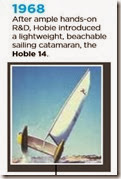 The museum will be participating in this fantastic event.
The museum will be participating in this fantastic event.
Date: Saturday 1st February, Time: 1pm, Location: Lady Denman Theatrette.
The Lady Denman Museum will be hosting a special presentation by Geoff Cater from Surf Research, he will be presenting a lecture on the role Hobie has played in successfully modernising the ancient Polynesian surfboard, outrigger canoe, and double-hulled sailing canoe, or "catamaran."
The ocean as a playground.
In conjunction with the lecture there will be a surf craft exhibition featuring an extensive collection of boards from 1958 – 1984 on display from 10.00AM-12.00PM in the grounds of the Lady Denman Museum.
If you head on down to Huskisson you will see large tents opposite the pub and all the boats lined up on the beach in readiness for the event.
29 January 2014
28 January 2014
27 January 2014
HMAS Creswell
A brief History.
Some of you may not be aware of the rich history of HMAS Creswell located at Captains Point Jervis Bay.
Selected as the location for the (RANC) Royal Australian Naval College in 1911 with the main buildings completed in 1915.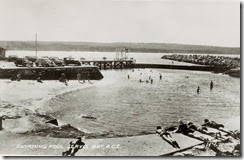 Holiday Accommodation.
Holiday Accommodation.
By the 1930’s the great depression had gripped the nation, funding cuts forced the closure of the college and the buildings were leased as hotels and guesthouses.
Here we see the base being used as a holiday destination.
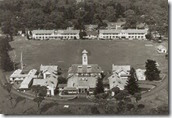
1956 and the government decided to return the RANC to Creswell, with the base back in full operation by 1958.
1987 The Staff Training School was established.
1993, the RAN School of Survivability and Ship Safety was relocated to the base.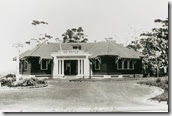 1998, The navy’s Lead Authority for leadership and management training was established.
1998, The navy’s Lead Authority for leadership and management training was established.
The base has undergone various changes over the years, The whole site is on the National Heritage Register, the old buildings are beautifully kept and essentially look the way they did when they were first built.
Recently the base had large amounts of money injected into infrastructure, this will keep the base at the forefront of Cadet Training, firefighting, damage control, and nuclear, biological and chemical defence training.
Before September 11th you were able to do scenic drives around the base, but unfortunately since the September 11th tragedy you can no longer enter the base unless you have prior permission.
 | 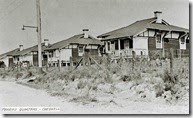 | 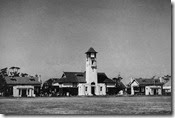 |
Deep in Thought
Taken this Morning Rob Slater guru Cameraman and Editor looking for inspiration for the Denman’s Blog.
Shooters
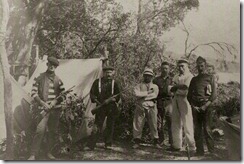 A small hunting party on the south coast.
A small hunting party on the south coast.
Guns were a normal part of Australian society in the 1800’s and 1900’s.
Hunting was very popular in rural Australia, with a plentiful supply of rabbit and kangaroo as well as wild birds. Many families survived the great depression in the 1930’s because they were able to hunt and put food on the table.
On a personal note: My grandmother refused to eat rabbit because that’s all she had when she was a child going through the great depression and the bad memories of that time for her, were still very strong.
20 January 2014
Hobie Alter
 The ocean as a playground.
The ocean as a playground.
To celebrate the 20th Hobie 16 World Championships in Jervis Bay Geoff Cater from Surf Research will be presenting a lecture on the role Hobie has played in successfully modernising the ancient Polynesian surfboard, outrigger canoe, and double-hulled sailing canoe, or "catamaran."
The presentation examines the pre-eminent role Hobart ‘Hobie’ Alter, creator of the Hobie Cat, played in the worldwide growth of recreational water sports in the 20th century and how the Polynesian concept of the ocean as a playground has been incorporated into modern Western culture.
Date: Saturday 1st February
Time: 1pm
Location: Lady Denman Theatrette.
In conjunction with the lecture there will be a surf craft exhibition featuring an extensive collection of boards from 1958 – 1984 on display from 10.00AM-12.00PM in the grounds of the Lady Denman Museum.
17 January 2014
The Coastal Steamer Mokau
By the 20th century shipping goods and people between ports was a thriving business.
Coastal Shipping was the fastest and most convenient way of transporting people and goods over the great distances between ports right around the world.
Australia was a vast country, communities were spread across great distances. Reliable rail and road transport were virtually nonexistent. The nation's resources needed transporting, wool, timber, oil, coal, silica were all transported by ship.
In the 1900s, coastal steamers made from timber and steel plied the sometimes treacherous coast. Without the weather forecasting equipment we take for granted in this age, these small hard working ships could easily run into trouble. Captains and crews were usually made up of experienced hardened sea going men, use to a life controlled by the elements.
The Australian coastline is littered with shipwrecks, stories and legends, the area around Jervis Bay and Wreck Bay was regarded by captains and crews as a particuarly dangerous place, many vessels were lost. The Corangamite, The Walter Hood, The Wandra,The Plutus, The Merimbula, The Hive, The Summer Cloud are just a few of the many wrecks in the area, a fine collection of relics from some of these ships are on display at the museum.
The Mokau
194 tons 35m x 6,9m x 2,7 meters Built at David Drake Limited in 1901 located at Balmain.
In 1922.
The Coastal Steamers Mokau, was transporting Silica from Ulladulla to Newcastle when she sprung a leak under her boiler, the leak was considered serious enough to seek shelter at the entrance to Sussex Inlet.
The cargo - Silica.
Occurs as the mineral quartz, a major constituent in many igneous and sedimentary rocks.
Bannister Headland at the northern end of Mollymook beach was the site of a silica crushing facility and loading jetty in the early 20th Century. In 1924, a tramway was constructed across Narrawallee Inlet to transport silica from mining leases near Conjola for preparation and shipping. The industry declined during World War II.
Flint Point was the main area mined for silica. Rocks were found to be almost pure silica were transported to Ulladulla, then shipped to Port Kembla and Newcastle to be crushed and made into refractory bricks to line the furnaces of the steelworks.
History of events leading to the loss of the Mokau.
January 18th Red Head:
The Mokau had been engaged in salvaging a punt that had sunk during wharf construction.
This required the Mokau to anchor bow to shore directly over the punt with lines fixed stem and stern.
The punt was raised by means of tackle rigged at the bow, and the ship was then hove in towards the shore, pushing the punt ahead of it, until the punt was on the beach.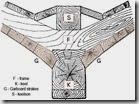 A diver employed by the contactor had stated he saw evidence of damage to the Mokau on the port bow and along the garboard strake and had advised the captain to head straight to Sydney for docking.
A diver employed by the contactor had stated he saw evidence of damage to the Mokau on the port bow and along the garboard strake and had advised the captain to head straight to Sydney for docking.
Instead, the Mokau headed straight to Ulladulla and loaded with 110 tons of silica rock.
Garboard strake illustration. click to enlarge.
January 19th Ulladulla:
The next morning it was noticed the Mokau was making water much faster than usual, and at lunchtime, the engineer informed the captain that it was about 13 inches per hour, He also stated she was “out of shape” after the loading was completed.
January 19th 4.30pm.
She left port bound for Wollongong, with the fore hatch uncovered, but shortly after leaving the harbour a strong southerly gale broke accompanied by heavy rain, thunder and lightning.
January 19th 6.30pm
The engineer had been continually monitoring the leak and by 6.30pm advised the master to head for the nearest port, They eventually made for Sussex Inlet, and got under the reef in smooth water dropping anchor.
January 20th.
As she was being moved the next day she touched bottom and never came off again. Meanwhile, the engineer pumped the ship dry but the master did not think it safe to go on.
Later while moving cargo, water was found rushing in through the deadwood.
The captain informed Red Head by telephone as soon as he could.
January 24th.
The underwriter's surveyors arrived to access the damage to the ship.
January 26th
On his advise the crew were landed and the vessel was abandoned by her owners Messrs, Kirton and Earnshaw as a total loss.
By then the sea was breaking over the stern, the anchors having carried away, she later came onto the beach and broke her back.
March 14th. The court case.
An enquiry into the circumstances attending the beaching and subsequent wreck of the steamer Mokau.
The court found that William Robinson master of the Mokau had been guilty of miss conduct in taking the vessel to sea in the face of an approaching storm in an unseaworthy condition and with her fore hatch uncovered, as a result of which she was compelled to run for shelter in Sussex Inlet, where she became a total loss and was abandoned.
The court called upon Captain Robinson to show cause why his certificate should not be cancelled.
The narrow entrance to Sussex Inlet is made up of constantly shifting sand bars. Floods and large southerly and easterly swells shift large amounts of sand.
Sonia Cropper, the owner of the holiday cabins located near the entrance to Sussex Inlet contacted the Museum saying she could see the outline of the Mokau in the shallow entrance to the river.
Sonia was familiar with the story of the Mokau, and this was the first time she had seen any evidence of the wreck appear.
Since then I have dived the wreck a number of times and have put together this short video of the last days of the Mokau and some vision of what remains today of this once proud coastal steamer.
Here is the link to a video of the last voyage of the Mokau and what remains underwater of her today. CLICK HERE TO SEE THE VIDEO – best viewed full screen.
David Drake Ship Builder coincidentally died in 1922.
This was only the beginning of this fascinating story, continue reading.
https://youtu.be/f8mNqif3pQE?list=UU_R7tNHlYo50zihH3rVkuAQ
16 January 2014
Galamban
13 January 2014
New Exhibition
The Dent family

George Dent senior.
Huskisson once had a thriving shipbuilding industry, ships of all sizes were launched at the ship building operation on the banks of Currambene Creek operated by George Dent.
The museum has a fantastic display of tools and photographs from the era. The floor of the display is made in the same fashion and materials as the decks of the ships built at Huskisson.
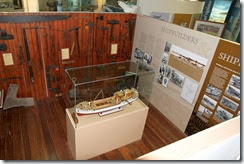 | 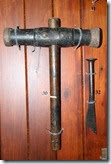 | 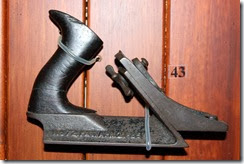 |

George Dent Junior.
George Dent moved his family from the Georges River area to Huskisson in 1861. George had been a timber-getter for the boat-builders on the Georges River in Sydney. Two of his sons, George Junior and Joseph became boat builders while his other two sons, James and William worked in the bush finding and felling the right timber for the boatbuilding.
William Wood joined George Dent Senior in the first shipyard, and later set up his own yard with other shipwrights joining them over the years. In the 1880s, George Dent Junior set up a new yard, and at the turn of the century, Joseph Dent did likewise. It was in his shipyard that the Lady Denman was built.

Joseph Dent on the left and his shipbuilding crew.

11 January 2014
On this Day in 1933
 Sir Charles Kingsford Smith.
Sir Charles Kingsford Smith.
At 2.50am on the 11th of January 1933, The Southern Cross prepared for take off along Seven Mile beach at Gerroa, watched by a cheering crowd of more than 1000 people, some of which had their headlights on to assist with the take off.
Much of the Shoalhaven came together to celebrate the start of Sir Charles Kingsford Smith's historic flight from seven-Mile beach, Gerroa to New Plymouth, New Zealand in 1933.
‘Smithy” as he was often called and his two crew completed the first commercial trans-Tasman flight in 14 hours and 10 minutes.
A local businessman then aged 10, recalls the occasion.
Read more
9 January 2014
On this Day
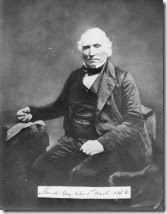 January 9th 1822 - Alexander Berry, in the vessel “Snapper” arrived at Shoalhaven.
January 9th 1822 - Alexander Berry, in the vessel “Snapper” arrived at Shoalhaven.
He was prevented from entering by a line of breakers and so sailed 3 miles south to enter by the Crookhaven River. Finding the northern arm separated by some 250 yards of sand spit from the southern arm, the party “hauled the boat across”. He later returned in June 1822 to settle in the area.
Alexander Berry (30 November 1781 – 30 November 1873) was a Scottish-born surgeon, merchant and explorer who in 1822 was given a land grant of 10,000 acres and 100 convicts to establish the first European settlement on the south coast of New South Wales, Australia.
This settlement became known as the Coolangatta Estate and later developed into what is now the town of Berry, named in honour of Alexander and his brother David.
In June 1822, Berry and Woolstonecraft purchased a small cutter, the Blanche, an old decked vessel of 15 tons and Berry returned to the Shoalhaven with Hume and assigned servants (convicts) Hamilton Hume, David Souter and Toodwit and Aborigine known to Europeans as Broughton, to develop his land grant there.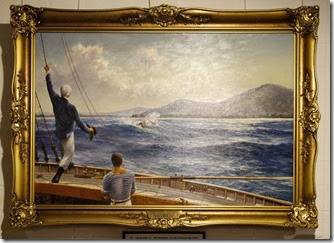
This painting by Ian Hansen shows the loss of poor Davison and Kelly at the entrance to Shoalhaven River aboard the cutter Blanch at 4pm on the 23rd June 1822.
Cutter Description: The Cutter during the 18th and 19th centuries was a small, single-masted vessel, fore-and-aft rigged, with two or more headsails, a bowsprit, with a mast set further back than in a sloop.
While attempting to cross the bar into the river in a small boat, two people drowned, including Davison, who was the boy that Berry had rescued from the 'Boyd'. Given the danger, Berry arranged to drag the Blanche across a sand bar that separated the Shoalhaven River from the Crookhaven River, with the Crookhaven entrance offering a safer passage. Hume then oversaw the digging of a canal in essence to keep the convicts occupied while Berry was away exploring, they eventually dug a channel two hundred and ninety yards long and 18ft wide at the surface and 4 ft wide at the base and an average depth of 3ft, quite a feat using only hand tools, thus constructing the first land navigable canal in Australia.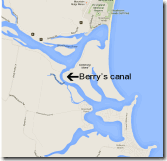 If you would like to see the Canal today, take the scenic trip across the Comerong Island Punt…what you will be travelling across is the canal..
If you would like to see the Canal today, take the scenic trip across the Comerong Island Punt…what you will be travelling across is the canal..
Biography Read more
Coolangatta Estate history Read more
Holidaying at Moona, Moona Creek
8 January 2014
Wreck of the hive
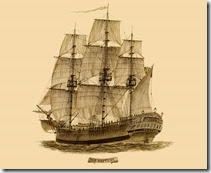 An example of the ships used to transport convicts around the time of the Hive.
An example of the ships used to transport convicts around the time of the Hive.
This image is in the public domain.
I have dived many wreck sites along the coast, they are always exciting, you get this amazing feeling when you come down onto the remains of a wreck, of course not many wrecks look like the ones in the movies, most timber wrecks have long since disintegrated, leaving only ballast blocks and some broken relics such as tiles,bottles and rusted iron and such, as time and the elements slowly disintegrate what little remains the opportunity for research slowly but surly disappears.
1837 the Convict ship the Hive, runs ashore south of Jervis Bay.
The Hive is one of the most significant wrecks in Australia, buried deep below the sand along Bhewerre Beach south of Jervis Bay.
Plenty of people have searched and done extensive research into the wreck but it’s exact location remained a mystery until 1994 when it was located under approximately two metres of sand and three metres of water, the buried hull was detected by Heritage Office Maritime Archaeologists using a magnetometer loaned from ADI Ltd.
With a little luck the sand has protected and preserved whatever remains. But the question still remains,.. how much is left ?
No one has seen the wreck exposed. “ that is, until recently”.
I was taking pictures at the old lighthouse when I ran into an old friend, the conversation turned to what I was doing at the museum, the lighthouse and the local wrecks. While on the subject of wrecks he casually mentions he had been fishing a few weeks before Xmas from his jet ski on a flat day close to the beach at Bherwerre, when he came across the remains of timber ribs sticking out of the bottom in a couple of meters of water, he described it as large, dark and wide with ribs on both sides sticking right out of the sand. He hadn’t heard of the Hive before and was unaware of the significance of his discovery, or that he is probably the only person to have ever seen the wreck exposed like this. A few weeks had passed since his sighting, so the next day I went to the location he described, but there was no sign of the wreck. He said it would have been easily seen from the shore as it was so close and so big, I have done repeated trips to the location walking up and down the beach on the to few flat, calm, clear days, without seeing anything, It looks as if it’s disappeared as quickly as it came.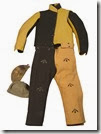 The sad tale.
The sad tale.
After picking up convicts at Dublin then Cork in Ireland, the Hive departed for Australia on 24 August 1835.The vessel ran aground on a sandy beach during the night of Thursday 10th of December 1835. There appeared to be a dispute amongst the officers regarding sailing directions set for the night, the captain finally ending the debate by exclaiming, "One person is sufficient to navigate the ship!". Unfortunately he was soon to be proven wrong.
The only loss of life occurred when the boatswain was tragically drowned in the surf whilst trying to save a young crew member in difficulties. The young man himself washed ashore safely. Once word of the wreck reached Sydney, rescue ships were sent to pick up the remaining passengers, crew and convicts as well as the ship's cargo. The Hive soon became a total wreck.
And like all good stories, there is a twist.
The Blackbird.
The Blackbird,a small former Government schooner of 67 tons, was engaged to salvage the Hive’s stores and anchoring out in Wreck Bay used her whaleboats to ferry the bulk of the salvable stores from the Hive . A sudden southerly gale blew up on the 15th January and with her anchors unable to hold her the Blackbird fetched up on the beach beside the Hive and became a total loss. Aboard was Captain Nutting, wrecked for the second time on Bherwerre Beach. The Captain walked back to Sydney for help.
Read more
After being involved in two ship losses in two months at the same location what was to become of Captain John Nutting.
Just one month later he was assisting the Captain of the Blackbird to remove stores from the Hive when the Blackbird ran into difficulties, and was run on shore as the only way of saving the crew. Captain Nutting returned to England on the Norfolk in February 1836 and a month later it was reported that he had been appointed to the command of the Avon owned by Captain Cole which conveyed oil to London. The friends of Captain Nutting were much gratified at this appointment as they considered he had not been fairly treated in Australia since his misfortune. A Court of Enquiry was held upon his conduct in the loss of the Hive at which he was not even allowed to be present, the result of which was laid before the Governor; and about a month after, when all the witnesses had left the Colony, he was made acquainted with the particulars and decision of the investigation. The Avon reached Australia by the following April and returned to England with oil. On the 20th May she fell in with great quantities of ice, and were surrounded with ice islands for over a week during which time the sea appeared as one continued mass of ice at times almost impassable. On the 30th they rounded the Horn from which time they were clear of the ice. REF: Free settler or Felon.
The importance of the Hive
The Hive wreck site is representative of the period of convict transportation to Australia, and the interaction between survivors of shipwrecks and Aborigines. The ship, its cargo, crew, military personnel and convicts were part of the later period of highly organised convict transportation. It survives as a rare example of a vessel engaged in this trade. The hull is the main surviving artefact and has the potential to provide information about the construction and fitting of one of His Majesty's prison ships during this period
Gazetted Historic Shipwreck.
The Hive is a gazetted Historic Shipwreck, under Section 6 of the Commonwealth Historic Shipwrecks Act 1976. The listing applies to the shipwreck and all relics associated with the shipwreck.
Read more.
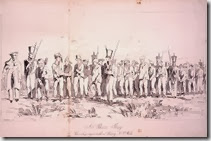
Here is a list of the convicts transported to Australia on the Hive in 1936, the crimes they were convicted for make interesting reading.

